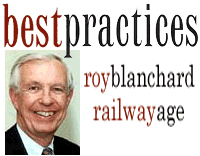|
BNSF is looking for strong shortline partners as they invest and divest for the greatest return. |
 e can expect shortline organic revenue growth to average 7% annually vs.
2.5% for the class 1s." – Matt Rose, CEO, Burlington Northern & Santa
Fe
e can expect shortline organic revenue growth to average 7% annually vs.
2.5% for the class 1s." – Matt Rose, CEO, Burlington Northern & Santa
Fe
The theme of October’s BNSF shortline meeting was simple and direct: Rose and company see shortlines outpacing the class 1s in revenue growth. They are looking for strong shortline partners as they invest and divest for the greatest return.
There are more shortline miles to come as BNSF streamlines the customer process and manages revenue sources to maximize return on investment. This month, as a continuing series on performance measurement, we’ll look at two key BNSF initiatives and how one non-BNSF shortline has read the tea-leaves.
To begin, Rollin Breedenberg, VP Service Design at BNSF, told the shortlines that the Transportation Service Plan (TSP) changes based on traffic volumes. As new carload trip plans come in, the TSP model identifies impact on velocity and consistency at the shipment level, the impact on customer service commitments and anticipated network loading and then makes requisite adjustments to the operating plan. But in order to be part of this process each shortline must be part of the TSP network.
For that reason alone successful shortline managers aggressively pursue signed interline service agreements (ISAs) to bring their railroads into the network and then measure performance against the ISAs. Consistent interchange times mean lower cost service and improved customer perception of service quality. That translates to greater customer value and wider railroad margins. Higher rates and lowered costs drive improved profits, and isn’t what every operator seeks?
Accurate and measurable interchange times add a second, less direct benefit. A shortline operator writes, "The class 1 operating ranks have been cut so deeply that it appears getting assistance on correcting mis-handlings is a thing of the past…much of the human contact has been lost." That’s the bad news. The good news is that mis-handlings are service failures and as such can be measured and fixed once root causes are documented. This requires no wide network of contacts or endless phone-tag. A well-placed e-mail will generally suffice, saving tons of time and aggravation.
Another way to add value to the transaction is to make it simpler. Archaic and arcane railroad pricing practices have long been one of the biggest barriers to winning new business -- and even more business from old business. Happily the rails are taking a page or two from the trucker's playbook, going to web-based market pricing.
The fact is that half the stations (waybill points, not little houses with agents) served by the class 1s represent 3% or less of the total revenue stream. There simply aren’t enough hours in the day to cover ‘em all, and web-based pricing is one way to make oneself available. As for the human touch, again it's yet a paradigm shift, though there are still a lot of older heads out there who are more comfortable being taken to lunch than they are playing web games. But that's changing, too, and the SLs are well-positioned to capitalize on the trends.
Combining efficient interchange, simplified pricing, and the shortlines' traditional "hunting and gathering" strength yields a powerful model. Take Tom Hoback’s Indiana Rail Road (IRR), for example. He writes, "Just a year ago we went up against another carrier and won a contract to supply 5 million tons (50,000 carloads) of western coal to an area utility. Even though our route – UP, CP, IRR -- was 100 miles longer our service design and trip planning process allowed the utility to move more coal with existing equipment sets.
"CP in particular was very helpful. We had to rebuild an abandoned four-mile spur in order to make a head-on move with CP. We shared the $1.25 million cost with CP to rebuild this track, which was rebuilt with our own people. We have implemented run-through power in conjunction with CP on other business as well, thereby improving service for a number of customers and improving locomotive and car utilization."
Tom adds that improved service design and predictable transit times have opened up other business opportunities as well. He modestly mentions GE refrigerators by the trainload – literally. A dedicated 25-car train a day out of Bloomington (IN) to CSXT at Indianapolis. At 100,000 carloads a year, IRR is truly a regional railroad to be reckoned with. Hoback again: "I've always believed that if you could run a railroad like a business and not like a railroad, you could do well. We've taken a railroad that was going to be abandoned in the 1970s, and since we acquired it in 1986, we've increased our traffic more than five times."
And all it takes is knowing what customers value, how to work with the class 1s to produce it, and smiling all the way to the bank.
